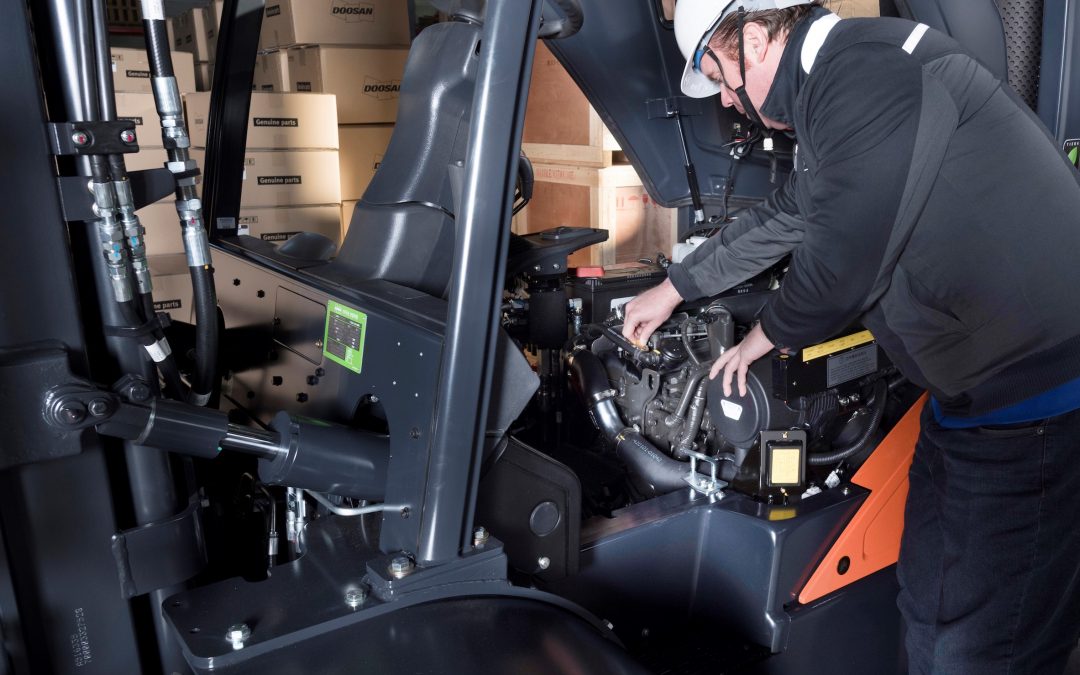If you operate a single forklift or a fleet of forklifts, then reliability and safety are going to be key priorities for you. Ensure both of these is helped by incorporating fork lift truck daily checks into your regular routine. But what forklift safety checks should you be doing, and why are they necessary?
What forklift checks should you be doing?
Your forklift daily checks should include the following two checks – the visual check, and the pre-operation check.
The visual check
First, you should do a general walkaround visual check of the forklift. This is your chance to spot anything that might need rectifying. Keep an eye on the general condition and cleanliness of the forklift. You should also think about the location of the forklift; is it safely situated? Are there obstructions around or overhead?
Check for the presence of a fire extinguisher, then you can move on to check the tyres. Check for damage, splits, or flats. If you’re unsure, check the air pressure using an accurate pressure gauge. Then check the propulsion system; some forklifts are run on diesel or LPG, and others via electricity. Check the fuel tank/battery for any corrosion or damage, and be sure they are securely mounted. Check the condition of the hydraulic hoses, look for any wear or discrepancies in hose quality.
Following that, you should check the forks. Be sure both forks are straight and level with one another. Check for any damage, cracks, or fractures. Ensure carriage teeth aren’t worn, chipped, or broken. The chain anchor pins should be in good condition, not loose or bent.
After that, check the cabin. Check the seatbelt, or harness if equipped, is in good condition and works properly. If there are seat locks, be sure they’re in position. Ensure all dials are readable. Before moving on, have a final look around the forklift to check for any fluid leaks, damp spots, or dripping.
The pre-operation check
Following a thorough visual inspection, it’s time to check the machine is ready for use. Check the pedals work properly and smoothly and listen for any untoward noises when braking. Check the parking brake is strong enough to hold against the light throttle. The deadman seat brake should also operate on getting off the seat.
The clutch and gearshift should engage smoothly. Check your panel that all gauges are working and showing appropriate readings. Test the horn to see if it’s loud enough to be heard in a busy working situation. Select reverse to check smooth engagement and proper reversing alarm activation. The steering should move fluidly and smoothly, with no noises or judders. Then, check the lift and tilt mechanism of the forks; both should also work smoothly. Check the cylinders after you’ve done this to ensure no further leaks. Following that, spend a few moments listening for any unexpected or unexplained noises, grinding, juddering, or the sound of air escaping from anywhere.
What should you do if you find a problem?
Forklift safety is the responsibility of the forklift operator. If you find any issues in the course of your daily checks, you should report them to your foreman, site supervisor, manager, or another appropriate member of staff. You should never drive any vehicle that you are not confident in the safety of. Following the highlighting of an issue, a trained technician should examine the problem to determine the next course of action. You should never be pressured into driving an unsafe forklift. If a forklift needs repairs, you can be found another machine to use or you will simply have to wait until the forklift has been suitably repaired.
Why do forklift daily checks matter?
Forklift checks are essential on a daily basis to ensure the safety of the forklift. Forklifts are potentially very dangerous vehicles if something goes wrong. A comprehensive list of daily checks should be undertaken to ensure that the vehicle is safe for use. Potential safety issues surrounding tyres, steering, braking, or the operation of the hydraulic system can all be reasonably avoided through diligent daily safety checks.
Something to consider is that daily safety checks do not mean only once a day. They should instead be instigated at the start of every shift. So, if a forklift is in operation through multiple operators in a day, every new operator should conduct the same list of safety checks before starting their shift.
The importance of uniform checks
Safety checks are essential, but it’s also essential to ensure that every operator understands what they should be checking. This means a unified safety checklist should be established and followed. It’s also important operators understand the difference between a part that is working as intended that should be noted as requiring maintenance soon, and one that is worn to the point the forklift should not be used until it’s replaced.
Forklift truck checks only take a few minutes, but they can help avoid costly and potentially seriously damaging accidents. Keeping your operators safe, your business running smoothly, and your fleet of forklifts in good condition is easy when you implement a policy of daily safety checks. Be sure to contact Budget Forktrucks Ltd for any further information or guidance.


